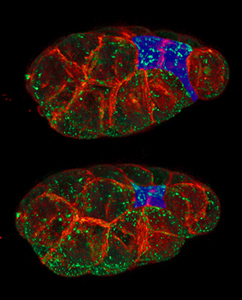Aril
An aril is a specialized outgrowth from a seed that partially or completely covers the seed. This structure is often fleshy and brightly colored, which can attract animals and aid in seed dispersal. Arils are found in various plant species and are an important feature in the reproductive strategy of these plants.
Structure and Function[edit]
The aril is typically a fleshy covering that develops from the seed stalk, known as the funiculus, or from the seed coat itself. It is distinct from the fruit, which develops from the ovary of the flower. The primary function of the aril is to attract animals, such as birds and mammals, which consume the aril and subsequently disperse the seeds.

In some species, the aril is edible and highly valued. For example, the aril of the nutmeg seed is known as mace, a spice used in cooking. The aril of the lychee fruit is the sweet, edible part that is consumed.
Examples of Arils[edit]
Nutmeg[edit]
The nutmeg tree produces seeds that are covered by a bright red aril known as mace. This aril is removed and dried to be used as a spice. The nutmeg seed itself is also used as a spice.
Lychee[edit]

The lychee fruit has a fleshy, sweet aril that surrounds the seed. This aril is the part of the fruit that is consumed, while the seed is discarded.
Yew[edit]

In the yew tree, the aril is a fleshy, red structure that surrounds the seed. Unlike many other arils, the yew aril is not edible due to the toxicity of the seed it encloses.
Role in Seed Dispersal[edit]
Arils play a crucial role in the dispersal of seeds. By attracting animals with their bright colors and fleshy texture, arils encourage animals to eat them. The seeds are then carried away from the parent plant and are often deposited in new locations through the animal's droppings, facilitating the spread of the plant species.
Morphogenesis and Development[edit]
The development of arils involves complex morphogenetic processes. The growth of the aril is often synchronized with the development of the seed, ensuring that the aril is mature and attractive to dispersers at the right time.

Apical Constriction[edit]
Apical constriction is a process that can be involved in the development of arils, as it is in many other plant and animal tissues. This process involves the contraction of cells at their apical surface, leading to changes in tissue shape and structure.

Mechanisms[edit]
The mechanisms of apical constriction involve the coordinated action of actin and myosin filaments within the cells. These proteins generate contractile forces that lead to the invagination or folding of tissues.

Stages[edit]
The stages of apical constriction can be observed in various developmental processes, including the formation of arils. These stages include the initial cell shape changes, the formation of a constricted apical surface, and the eventual stabilization of the new tissue structure.

Related Pages[edit]
Ad. Transform your life with W8MD's Budget GLP-1 injections from $75


W8MD offers a medical weight loss program to lose weight in Philadelphia. Our physician-supervised medical weight loss provides:
- Weight loss injections in NYC (generic and brand names):
- Zepbound / Mounjaro, Wegovy / Ozempic, Saxenda
- Most insurances accepted or discounted self-pay rates. We will obtain insurance prior authorizations if needed.
- Generic GLP1 weight loss injections from $75 for the starting dose.
- Also offer prescription weight loss medications including Phentermine, Qsymia, Diethylpropion, Contrave etc.
NYC weight loss doctor appointmentsNYC weight loss doctor appointments
Start your NYC weight loss journey today at our NYC medical weight loss and Philadelphia medical weight loss clinics.
- Call 718-946-5500 to lose weight in NYC or for medical weight loss in Philadelphia 215-676-2334.
- Tags:NYC medical weight loss, Philadelphia lose weight Zepbound NYC, Budget GLP1 weight loss injections, Wegovy Philadelphia, Wegovy NYC, Philadelphia medical weight loss, Brookly weight loss and Wegovy NYC
|
WikiMD's Wellness Encyclopedia |
| Let Food Be Thy Medicine Medicine Thy Food - Hippocrates |
Medical Disclaimer: WikiMD is not a substitute for professional medical advice. The information on WikiMD is provided as an information resource only, may be incorrect, outdated or misleading, and is not to be used or relied on for any diagnostic or treatment purposes. Please consult your health care provider before making any healthcare decisions or for guidance about a specific medical condition. WikiMD expressly disclaims responsibility, and shall have no liability, for any damages, loss, injury, or liability whatsoever suffered as a result of your reliance on the information contained in this site. By visiting this site you agree to the foregoing terms and conditions, which may from time to time be changed or supplemented by WikiMD. If you do not agree to the foregoing terms and conditions, you should not enter or use this site. See full disclaimer.
Credits:Most images are courtesy of Wikimedia commons, and templates, categories Wikipedia, licensed under CC BY SA or similar.
Translate this page: - East Asian
中文,
日本,
한국어,
South Asian
हिन्दी,
தமிழ்,
తెలుగు,
Urdu,
ಕನ್ನಡ,
Southeast Asian
Indonesian,
Vietnamese,
Thai,
မြန်မာဘာသာ,
বাংলা
European
español,
Deutsch,
français,
Greek,
português do Brasil,
polski,
română,
русский,
Nederlands,
norsk,
svenska,
suomi,
Italian
Middle Eastern & African
عربى,
Turkish,
Persian,
Hebrew,
Afrikaans,
isiZulu,
Kiswahili,
Other
Bulgarian,
Hungarian,
Czech,
Swedish,
മലയാളം,
मराठी,
ਪੰਜਾਬੀ,
ગુજરાતી,
Portuguese,
Ukrainian